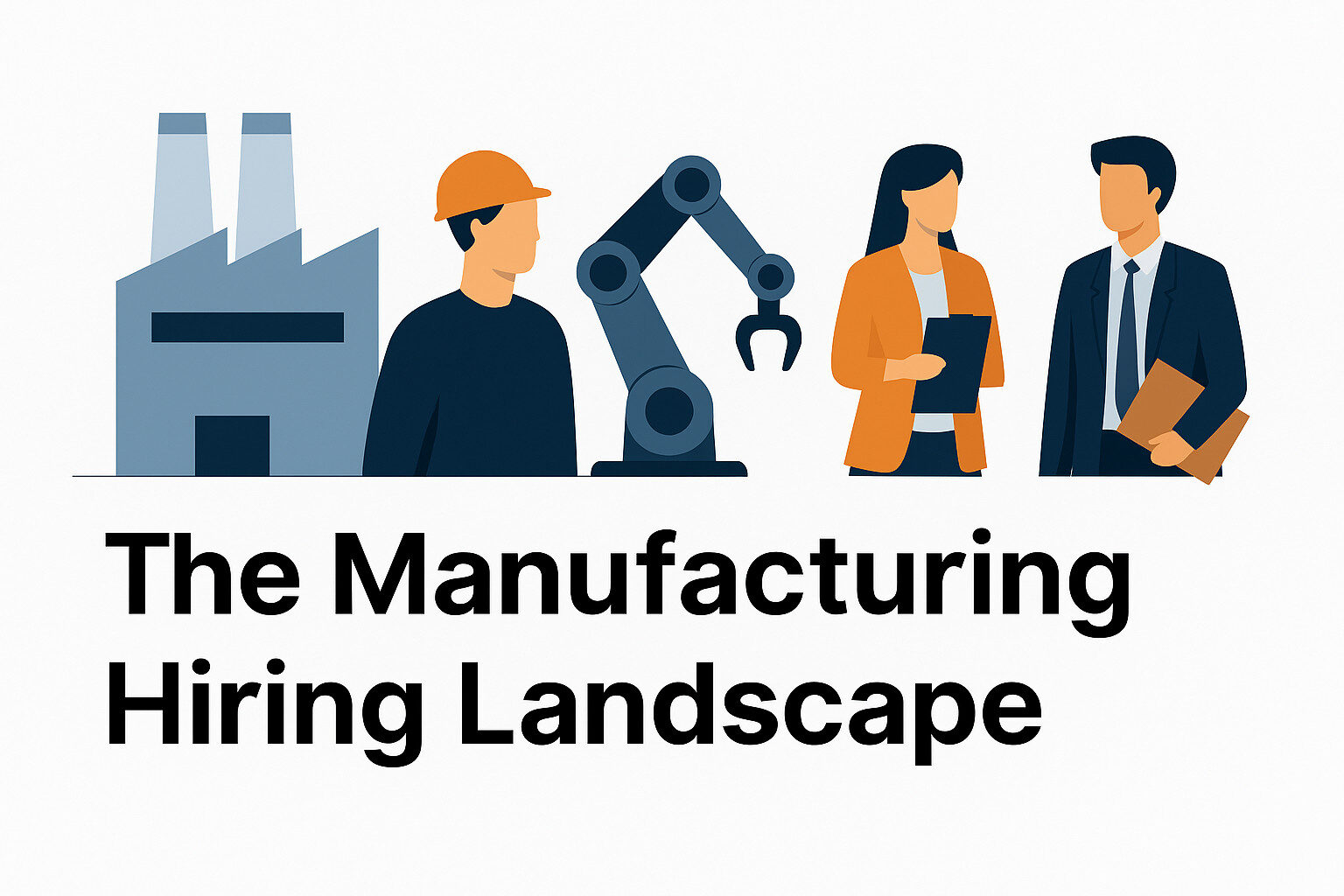In today’s competitive labor market, attracting and retaining skilled talent in the manufacturing sector is more challenging than ever. With increased automation, retiring workers, and a widening skill gap, manufacturing leaders must rethink how they source, engage, and hire candidates. This article outlines practical, data-driven recruitment strategies for manufacturing leaders to meet today’s workforce demands and prepare for long-term success.
The Manufacturing Hiring Landscape in 2025

According to the National Association of Manufacturers (NAM), over 2.1 million manufacturing jobs in the U.S. could go unfilled by 2030 due to skill shortages and retirements. Job openings are especially critical in roles like production supervisors, maintenance managers, machinists, quality engineers, and plant managers.
Current Trends:
- High demand for multi-skilled technicians and team leads
- Rising costs of mis-hires due to production downtime
- Greater competition from adjacent industries (e.g., logistics, tech)
These pressures make it vital for hiring leaders to adopt structured, proactive, and people-first recruitment strategies.
1. Define the Ideal Candidate Profile (ICP)
The first step in any successful recruitment strategy is clarity. Manufacturing roles are diverse—what works for one facility might not work for another.
What to Include:
- Hard skills: certifications (e.g., Six Sigma, CNC programming), machinery experience
- Soft skills: communication, safety mindset, leadership under pressure
- Operational metrics: OEE, lean manufacturing exposure
- Cultural fit: shift availability, team environment, company values
Tip: Use a standardized Job Overview Questionnaire to collect all the above for every open role.
2. Build a Multi-Channel Sourcing Strategy
Gone are the days of posting to one job board and waiting. Today’s best manufacturing talent needs to be found, not just attracted.
Channels to Include:
- Industry job boards (e.g., ManufacturingJobs.com, SME)
- Employee referral programs
- LinkedIn outreach and groups
- Skilled trade schools and community colleges
- Veteran and military transition programs
Example: A Tier 1 supplier used a combination of LinkedIn automation and military transition sourcing to hire 6 maintenance supervisors in under 45 days.
3. Streamline Screening with Structured Criteria
Manufacturing leaders often rely on gut instinct to assess candidates—but structured criteria leads to faster, fairer, and more consistent results.
Use:
- Scorecards with weighted competencies
- Screening questions tailored to plant experience
- Video-based screening for shift availability and safety awareness
Benefit: Cuts down on interview rounds and increases confidence in shortlists.
4. Invest in Employer Branding for Frontline Roles
While executive and engineering roles get polished job ads, hourly and frontline leadership roles often lack compelling messaging.
Highlight:
- Stability of manufacturing jobs
- Career path from floor to leadership
- Shift premiums and performance incentives
- Safety records and benefits
Tip: Use real employee stories in your content and social media to build trust.
5. Reduce Time-to-Hire Without Cutting Corners
Top manufacturing candidates are on the market for less than 10 days. A drawn-out process = lost talent.
Best Practices:
- Schedule interviews within 3 business days of application
- Pre-assign hiring managers for fast feedback
- Automate calendar scheduling and reminders
- Track every stage with ATS or spreadsheet
Metric to Watch: Time-to-accept offer — should be under 21 days.
6. Use Skill Assessments Where It Counts
Hands-on roles benefit from hands-on tests. Don’t guess—assess.
Tools to Consider:
- Simulation software for CNC, PLC, or forklift operation
- Situational judgment tests for team leads and supervisors
- Basic mechanical aptitude tests
Example: A Midwest food manufacturer saw a 30% increase in retention by using a 20-minute pre-hire test for production line workers.
7. Tailor Your Offer Strategy for Industrial Talent
Candidates in manufacturing value different things than office-based hires.
Focus On:
- Predictable schedules and overtime policy
- Bonus eligibility and safety rewards
- Path to lead/operator roles
- Health, dental, and retirement benefits
Tip: Share a one-pager during the final interview that shows a “Day in the Life” and path to promotion.
8. Strengthen Onboarding and First 90 Days
Turnover is highest within the first 30–90 days. Proactive onboarding changes that.
Key Steps:
- Assign a buddy or trainer
- Give a printed checklist of week 1 tasks
- Set 30/60/90-day goals with the supervisor
- Schedule pulse check-ins at day 7, 30, and 60
Benefit: Builds clarity, confidence, and connection.
9. Partner with Manufacturing-Focused Recruiters
Generalist recruiters rarely understand the nuances of safety, downtime risk, and cross-training. A specialized recruiter:
- Speaks your language (OEE, GMP, SQF, union vs. non-union)
- Maintains a ready-to-deploy bench of qualified candidates
- Provides market intel (comp, title trends, location heat maps)
Example: One of Talent Traction’s clients reduced time-to-fill by 48% by using our 5-step structured hiring process across 3 plants.
Final Thoughts
Effective recruitment strategies for manufacturing leaders require more than job ads and gut instinct. They require clarity, structure, speed, and empathy.
Start by defining your ICP, expanding your sourcing reach, assessing talent with consistency, and onboarding them with purpose. Most importantly—treat hiring as a team sport.
When done right, the results are measurable: faster time-to-fill, lower turnover, and higher productivity.
Need help building or refining your manufacturing hiring strategy? Talent Traction helps industrial organizations hire better, faster, and smarter.




